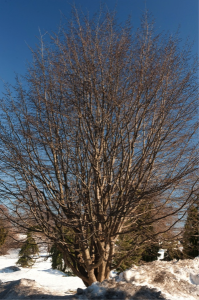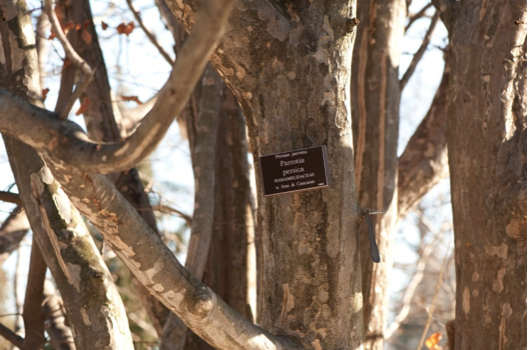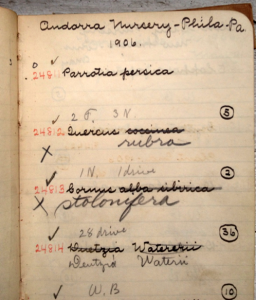Persian Parrotia: A Century of Interest
Posted in Horticulture on April 4 2014, by Jon Peter
Jon L. Peter is the NYBG’s Plant Records Manager. He is responsible for the curation of The Lionel Goldfrank III Computerized Catalog of the Living Collections. He manages nomenclature standards and the plant labels for all exhibitions, gardens, and collections, while coordinating with staff, scientists, students and the public on all garden related plant information.

I feel very fortunate that I get to enjoy one of my favorite trees in the garden on a daily basis. I actually park my car partially underneath its canopy flanking the Benenson Ornamental Conifers parking lot. With such frequent viewing, I get to enjoy the progress this plant makes throughout the year.
Parrotia persica, commonly known as Persian parrotia or Persian ironwood (in reference to its very dense wood) is an excellent medium-sized tree that is interesting in all four seasons. It features similar leaves, twigs, flowers, and fruits to its close relative the witch-hazel (Hamamelis), but is far less common in cultivation.
Parrotia is named in honor of F.W. Parrot, a German naturalist who traveled in the Caucasus region in the early 1830s. The specific epithet persica derives from the tree’s native habitat of the northern Alborz Mountains of Iran and Azerbaijan (formerly Persia).
The bark of Parrotia persica is what really makes this species stand out, especially through the long winter months. The camouflaged appearance of its exfoliating bark makes for an interesting contrast in all seasons, but looks especially beautiful when set against a backdrop of snow.

The flowers of this species are also quite fascinating, although not as noticeable as those of its relative the witch-hazel. The flowers are a rich, dark pink to purple color that contrasts the velvety brown bud scales that they emerge from in late winter or early spring. Further, the flowers differ from Hamamelis in that they lack flower petals—the vibrant color comes from the flower stamens. The flowers appear before the leaves and this year they are just beginning to show some emerging color, which is definitely later than what we are used to seeing in the Bronx.
In my position as Plant Records Manager, I track all plants throughout the garden and the associated data that goes along with them. The accession data for this particular Parrotia persica is fascinating. We actually have three living plants (of the original five received) from the same provenance (NYBG Accession 24811) which was received from Andorra Nursery, Chestnut Hill, PA in 1906. This means that these plants are at least 108 years old and perhaps closer to 115 years old based on the time that they spent growing in the nursery.

Andorra Nursery is no longer active today, but was once the largest tree nursery (1,400 acres) east of the Mississippi River. This makes these plants some of the oldest and largest of their kind in the country, and some of the finest specimens I have ever personally witnessed.
The other two specimens of the same accession, age, and beauty can be found near the School Group Picnic Pavilion and one along Conservatory Drive, near the northwest corner of the Enid A. Haupt Conservatory.
Parrotia persica really is a four-season treasure. You can enjoy the multi-colored bark in winter, the delicate flowers as they burst open in spring, the dark glossy leaves in summer, and the fruits and outstanding fall color displayed in autumn. Whenever you see them, these three old specimens will be sure to impress.


Delighted to read about this tree. I didn’t know it, and I love Hamamelis .
Thank you.